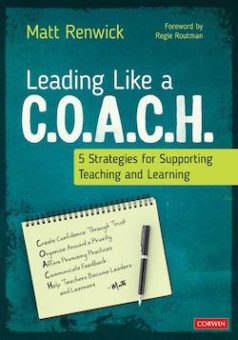The Principal’s Role in Supporting New Tech
By Matt Renwick
 As society experiences increasing complexity, educators and education struggle to keep up.
As society experiences increasing complexity, educators and education struggle to keep up.
A recent example: ChatGPT, created by OpenAI, is artificial intelligence that can create novel written responses to someone’s query or request. ChatGPT uses information available on the Internet to generate an answer to a question or an original article on a topic.
Imagining a secondary teacher’s possible initial reaction of worry or suspicion, I tried ChatGPT out with my 8th grade daughter on hand.
Our query: “Write a five paragraph essay summarizing the three major themes of The Last Cuentista (a Newbery-award winning middle-level novel).
The essay it created around storytelling, cultural identity, and the power of family was impressive. Yet if it were handed in to a teacher as written, it may not have passed a teacher’s threshold for high-quality writing.
For example, ChatGPT was confused about who was the main character (see italicized phrase).
“Donna Barba Higuera’s The Last Cuentista is a captivating novel that revolves around a young boy named Miguel and his journey to discover his identity and heritage. Throughout the story, there are three significant themes that emerge, including the importance of storytelling, the struggle of cultural identity, and the power of family.”
Miguel is the brother to Petra; Petra is the story’s protagonist.
As the piece was generating, I glanced at my daughter. Eyes wide, she saw me looking at her and then quickly stated, “I wouldn’t use this for class, you know. That’s cheating.”
I laughed, affirmed that I knew she was an honest person, and then asked how a student might be able to use this tool for learning. She was unsure, so I offered a few ideas.
1. “Imagine a student who didn’t have a lot of experience or background knowledge in reading a science fiction novel like this. They could use this as a reading guide to help identify evidence of the themes.”
2. “Or, a student could delete most of the content and leave just the first sentence of each paragraph to rewrite in their own words. They could write using the outline as a template.”
3. “Or, a teacher could print out a copy of this essay, hand it out to students, and tell them ‘This is a minimally effective piece of writing. As we read The Last Cuentista together, you will revise it and make it better.’ The whole unit could focus on revision.”
My daughter silently nodded, acknowledging these ideas as a child of an educator – a win in my book!
Supporting teachers’ exploration and use of evolving tech
The point to be made here is not whether ChatGPT is good or bad, or whether any technology should garner a similar assessment. Rather, my interest is in how we as school leaders support teachers to engage in professional dialogue, discussion, and decision-making about technologies and other new ideas in education.
Given the necessary time, space, and structure, I am confident educators can develop unique ideas for applying tools to improve the learning experience for students. Let’s use ChatGPT as an example.
Facilitating professional learning around ChatGPT as an instructional leader
#1 – Start with an essential question.
To begin a professional learning session, I could pose the following question: “How might ChatGPT help or hinder classroom instruction?” Then I would encourage teachers to explore, talk, and share with each other as they tried the AI tool out for themselves.
For faculty with little background knowledge around this topic, consider George Couros’s question – What are AI and ChatGPT, and how is it different from Google? – to build off of teachers’ prior knowledge.
#2 – Reduce professional learning plans to a minimum.
Ample time and space for professional conversations is uncommon in education. This is largely due to lack of respect and trust in the teachers we have entrusted to educate our kids.
Leaders can disrupt this attitude by minimizing how much “teaching” we actually do during professional learning and extend our confidence in their capacity through our actions.
Knowing idle time can lead to a lack of focus, consider facilitating a Q&A board on chart paper or a digital tool such as Jamboard to host an asynchronous discussion. When someone has a question, encourage them to post their inquiry publicly so the group can explore it together.
#3 – Provide teachers with a framework for integrating technology in their instruction.
As an example, teachers can use the following questions based on criteria for effective technology implementation from John Hattie’s book Visible Learning (Routledge, 2009) to critically guide a ChatGPT exploration:
✦ Are diversity teaching strategies promoted through the use of the technology?
✦ Are there multiple opportunities for student learning (e.g. deliberative practice, increasing time on task)?
✦ Are the students (vs. the teacher) in “control” of learning?
✦ Is peer learning optimized for students?
✦ Is feedback from peers as well as from teachers optimized for students?
#4 – Follow up, discuss, and celebrate.
Accountability doesn’t have to be a bad thing. As a leader, we can create “positive accountability” by checking into classrooms and asking teachers questions about the implementation process.
1. How has the implementation of this technology gone so far for you?
2. What’s working for your students? What’s not?
3. What have you learned from this process?
Anything the teacher offers can be a point for future conversation and hopefully celebration. Teachers have been asked to do so much over the last three years due to the pandemic. Any attempts with innovation should feel like a win for them. We can support teachers by acknowledging their reality through dialogue and by recognizing their efforts to improve.
The new technologies to come
There will be new technologies introduced to the world in the future; how will educators navigate the next ChatGPT?
Teachers who are lifelong learners and are trusted to make responsive decisions with the help of time, space, frameworks, and support will be best positioned to manage these types of changes. As school leaders, we create these conditions for success.
For a summary of this post’s process, try this template.

Matt’s latest book, with a foreword by Regie Routman, is Leading Like a C.O.A.C.H. – 5 Strategies for Supporting Teaching and Learning (Corwin, 2022). You can subscribe to his popular free Read by Example newsletter (and explore the archives) at his website. Follow him on Twitter @ReadByExample. Find his MiddleWeb articles and reviews here.
AI image by Alexandra_Koch from Pixabay































